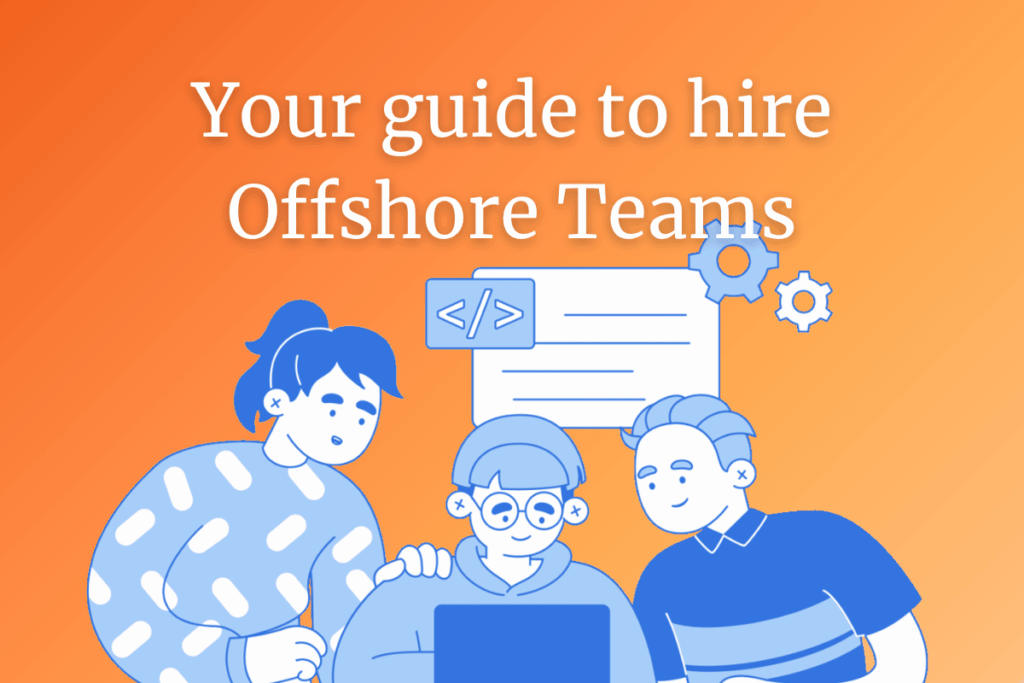When hiring an offshore development team, businesses reap significant benefits, including cost savings of up to 60%, access to specialized skills, and the ability to scale teams rapidly without the overhead of local hiring.
Yet the reality isn’t always smooth sailing.
Many companies have discovered that offshore development comes with its own set of challenges: communication barriers, quality inconsistencies, time zone coordination issues, and cultural misalignments that can derail projects and strain budgets. The difference between offshore success and failure often lies not in choosing the cheapest option, but in implementing the right strategies from the start.
This comprehensive guide outlines the essential best practices that separate successful offshore partnerships from costly disappointments, helping you navigate potential pitfalls while maximizing the substantial benefits that offshore development can deliver.
Why Choose Offshore Development Teams?
Offshore development offers compelling advantages that have made it a cornerstone of modern business strategy. Companies can access a vast pool of skilled developers at competitive rates while maintaining flexibility in scaling their technical capabilities. The time zone differences can work in your favor, creating a continuous development cycle where work progresses around the clock.
Cost efficiency remains one of the primary drivers, with businesses often saving 30-60% on development costs compared to domestic hiring. Beyond financial benefits, offshore teams provide access to specialized skills that may be scarce in your local market, particularly in emerging technologies like AI, blockchain, and cloud computing.
Define Your Project Requirements Clearly
Before reaching out to potential offshore partners, you need to know what you want to build and why. Clarify your goal first, then invest your time in creating detailed project specifications. Document your technical requirements, expected deliverables, timeline constraints, and quality standards. This clarity will serve as the foundation for evaluating potential teams and setting realistic expectations.
The SMART goals framework is a useful tool for defining your objectives.
Consider the complexity of your project and whether it requires specialized expertise. Complex enterprise applications may require teams with specific industry experience, while simpler projects might benefit from more cost-effective generalist developers.
Here’s what you should include in your Software Requirements Specification (SRS) document:
- Overview: Product introduction, objectives, and other info (target users, market, etc.)
- Requirements: scope of work, functional requirements, non-functional requirements, interface
- requirements, system architecture requirements, data requirements.
- Appendix: References, acceptance criteria, risk assessment, and assumptions.
Establish Your Budget and Timeline
Determine a realistic budget that accounts for more than just development costs. Factor in project management expenses, communication tools, potential travel costs, and buffer funds for scope changes. Remember that the cheapest option rarely delivers the best value.
Create a timeline that accommodates potential delays due to time zone differences, cultural holidays, and the initial ramp-up period. Offshore projects typically require 15-20% more time initially as teams establish workflows and communication patterns.
Set Clear Success Metrics and KPIs
Define measurable success criteria before your project begins, not after it ends. Establish specific key performance indicators that align with your business objectives, such as code quality scores, delivery timeline adherence, bug resolution rates, and stakeholder satisfaction metrics.
Create both short-term milestones and long-term success benchmarks. Short-term metrics might include sprint completion rates and code review pass rates, while long-term indicators could focus on user adoption rates, system performance, and maintenance costs. Having these metrics defined upfront ensures both you and your offshore team are working toward the same definition of success.
Assess Technical Capabilities and Cultural Fit
Technical competence is non-negotiable, but cultural alignment often determines project success. During the evaluation process, assess communication styles, work ethics, and problem-solving approaches. Teams that understand your business culture and can adapt their working methods accordingly will integrate more seamlessly with your operations.
Request technical interviews with key team members who will work on your project. Evaluate not just their coding skills but their ability to understand requirements, ask clarifying questions, and propose solutions.
Choose a Partner with Relevant Industry Experience
Industry-specific knowledge can make the difference between a good development team and an exceptional one. Look for offshore partners who have successfully delivered projects in your sector, whether that’s fintech, healthcare, e-commerce, or enterprise software. They’ll understand your regulatory requirements, user expectations, and industry-specific technical challenges.
Ask potential partners to provide case studies and references from similar projects. A team that has built healthcare applications will understand HIPAA compliance requirements, while an e-commerce specialist will know the intricacies of payment processing and inventory management systems. This domain expertise reduces project risk and often leads to more innovative solutions.
Establish Clear Communication Protocols
Effective communication forms the backbone of successful offshore relationships. Define primary communication channels, meeting schedules, and response time expectations from the outset. Utilize a combination of synchronous and asynchronous communication methods to accommodate time zone differences.
Implement daily stand-ups, weekly progress reviews, and monthly strategic check-ins. Use collaboration tools like Slack, Microsoft Teams, or similar platforms for real-time communication, and maintain detailed documentation in shared repositories.
Demand Full Transparency and Access
Transparency isn’t just nice to have—it’s essential for offshore success. Insist on complete access to project management tools, code repositories, testing environments, and progress reports. Your offshore team should provide the same level of visibility you’d expect from an internal team.
Establish real-time dashboards that show project status, bug reports, and development progress. Regular access to development environments allows you to review work in progress rather than waiting for formal deliverables. This transparency enables early identification of issues and ensures alignment with your expectations throughout the development process.
Set Clear Quality Standards and Testing Protocols
Define quality metrics and acceptance criteria before development begins. Establish coding standards, documentation requirements, and testing protocols that align with your company’s standards. Regular code reviews and automated testing should be non-negotiable components of your development process.
Implement continuous integration and continuous deployment (CI/CD) pipelines to catch issues early and maintain code quality throughout the development cycle. This approach reduces the risk of major problems emerging late in the project timeline.
Develop Risk Mitigation Strategies
Identify potential risks, including communication barriers, technical challenges, scope creep, and resource availability. Create contingency plans for each identified risk and establish escalation procedures for critical issues.
Consider implementing a pilot project or proof of concept before committing to larger engagements. This approach allows you to evaluate the team’s capabilities and refine your processes with lower stakes.
Treat Your Offshore Team Like In-House Developers
The most successful offshore partnerships eliminate the distinction between “us” and “them.” Provide your offshore team with the same tools, access, and resources you’d give internal developers. Include them in company-wide communications, celebrate their achievements, and invest in their professional development.
Give offshore team members direct access to stakeholders and end users when appropriate, rather than filtering everything through intermediaries. This direct connection improves understanding of requirements and builds a stronger commitment to project success. When offshore developers feel like valued team members rather than outsourced resources, they deliver better results and stay engaged longer.
Putting These Best Practices into Action: A Partnership Approach
At SHIFT ASIA, we understand that successful offshore development goes beyond just coding; it’s about building genuine partnerships that drive your business forward. With years of experience serving clients across diverse industries, we’ve refined our approach to embody all the best practices outlined in this guide.
Proven Industry Expertise Across Sectors
Our development teams bring deep domain knowledge across multiple industries, from fintech and healthcare to eCommerce and enterprise software. We don’t just write code; we understand your business challenges and regulatory requirements. Our portfolio includes successful projects for startups scaling rapidly and established enterprises modernizing their technology stack.
Transparency and Communication Excellence
We believe in complete transparency from day one. Our clients have real-time access to project dashboards, code repositories, and development environments. Regular communication isn’t just scheduled; it’s embedded in our culture. Our English-proficient teams ensure clear, consistent communication across all time zones.
Quality-First Development Approach
Every project follows rigorous quality assurance protocols, including automated testing, code reviews, and continuous integration practices. We establish clear success metrics and KPIs at project initiation, ensuring alignment with your business objectives throughout the development lifecycle.
Seamless Team Integration
When you work with SHIFT ASIA, our developers become an extension of your team. We adapt to your existing workflows, tools, and company culture. Our teams participate in your stand-ups, planning sessions, and strategic discussions, ensuring true collaboration rather than simple task execution.
Flexible Engagement Models
Whether you need a dedicated development team, specific expertise for a short-term project, or long-term strategic partnership, SHIFT ASIA offers flexible engagement models that scale with your needs. Our approach prioritizes building lasting relationships that evolve with your business growth.
Conclusion
Successfully hiring and managing offshore development teams requires careful planning, clear communication, and ongoing commitment to relationship building. By following these best practices, you can harness the benefits of global talent while minimizing common pitfalls that derail offshore projects.
The key to offshore success lies in treating it as a strategic partnership rather than a simple cost-cutting exercise. When done correctly, offshore development can provide access to world-class talent, accelerate innovation, and create sustainable competitive advantages for your business.
Start with clear objectives, invest in proper planning and communication infrastructure, and focus on building strong relationships with your offshore partners. With the right approach, offshore development teams can become invaluable extensions of your organization, driving growth and innovation for years to come.
Ready to experience the difference that a truly strategic offshore partnership can make? Contact SHIFT ASIA today to discuss how we can help accelerate your development goals while maintaining the highest standards of quality and communication.
ContactContact
Stay in touch with Us

